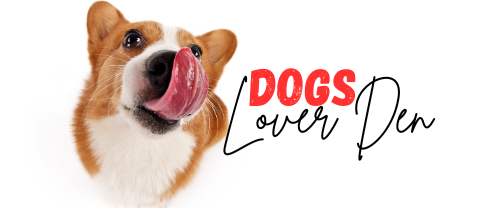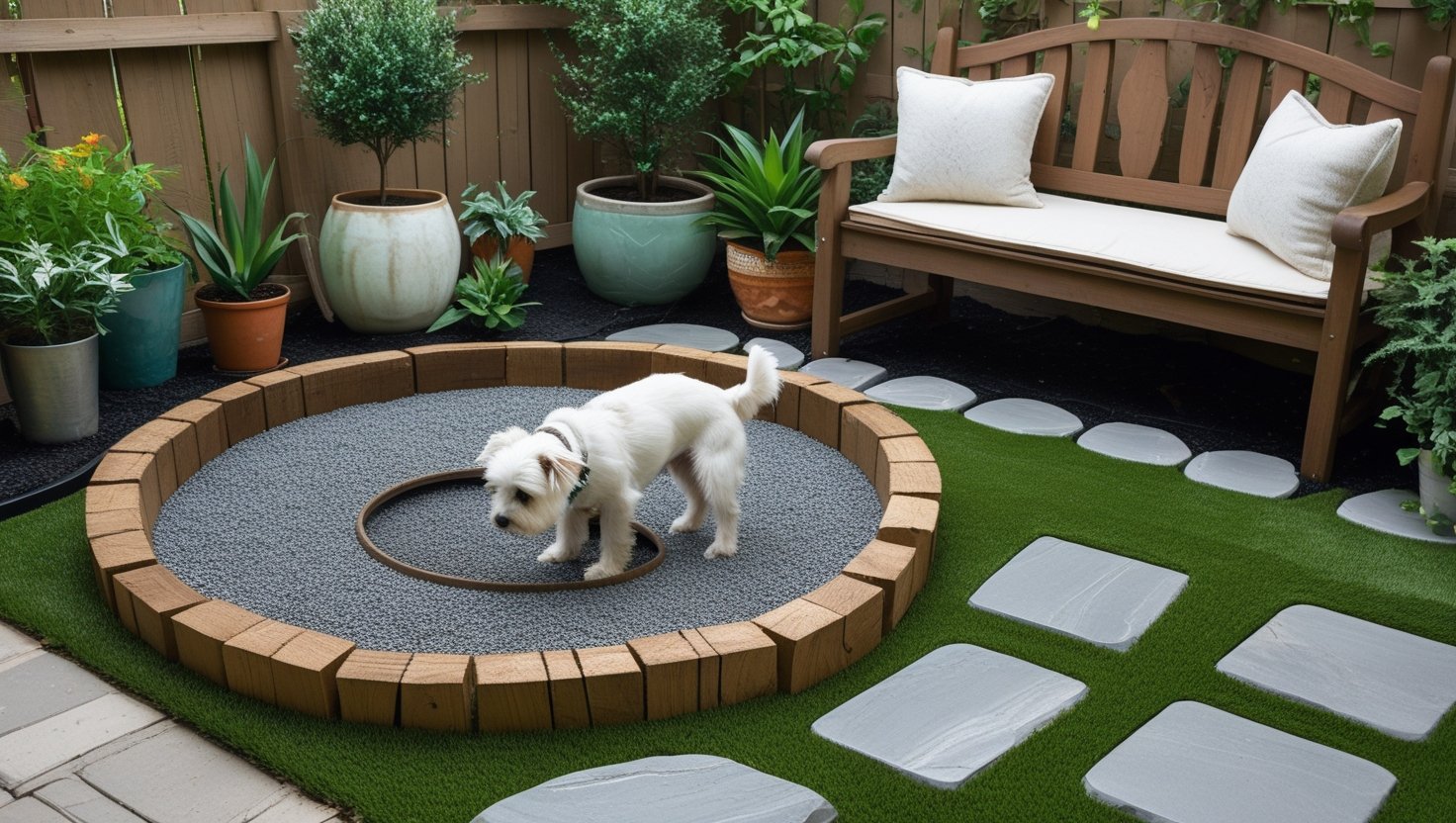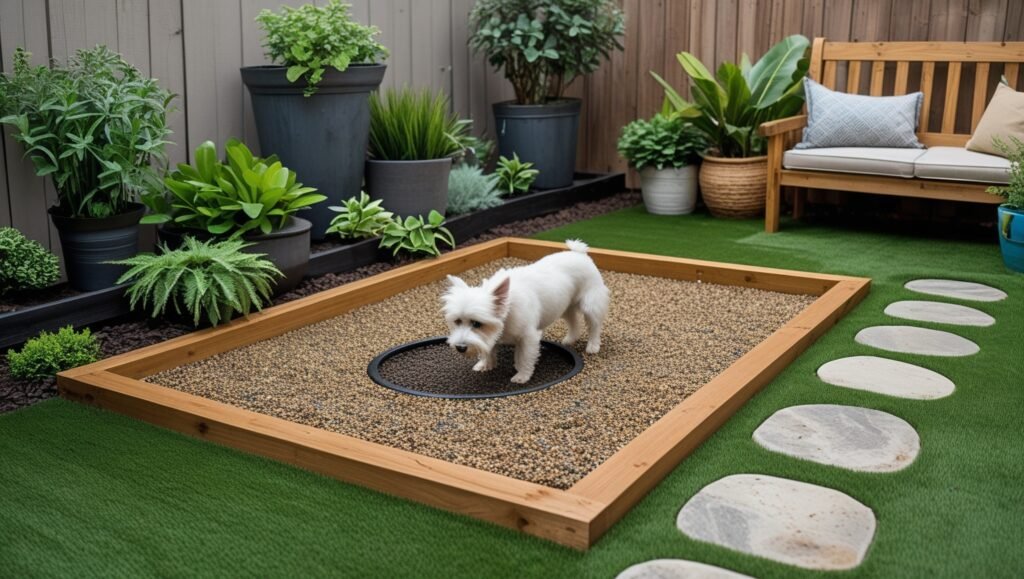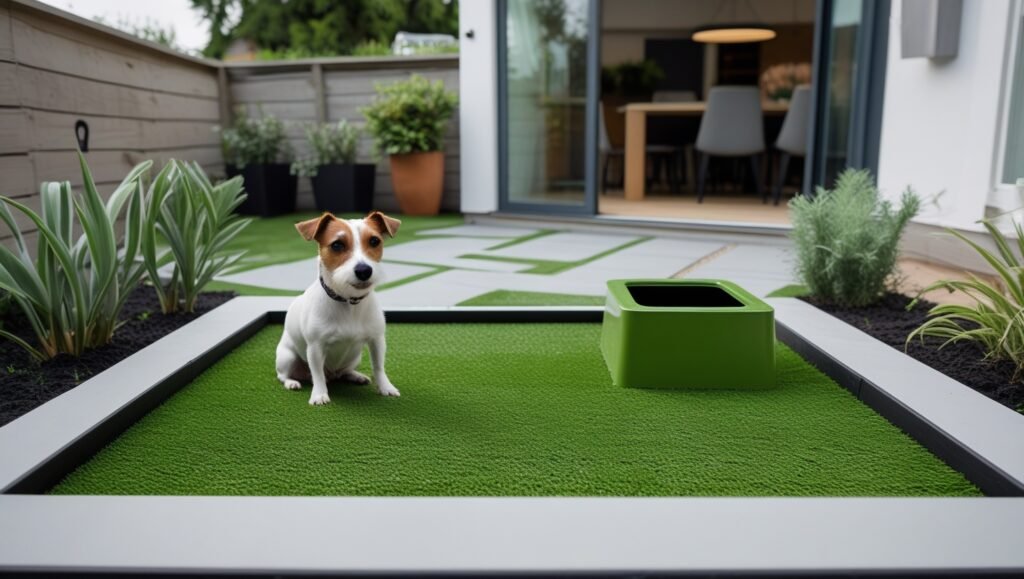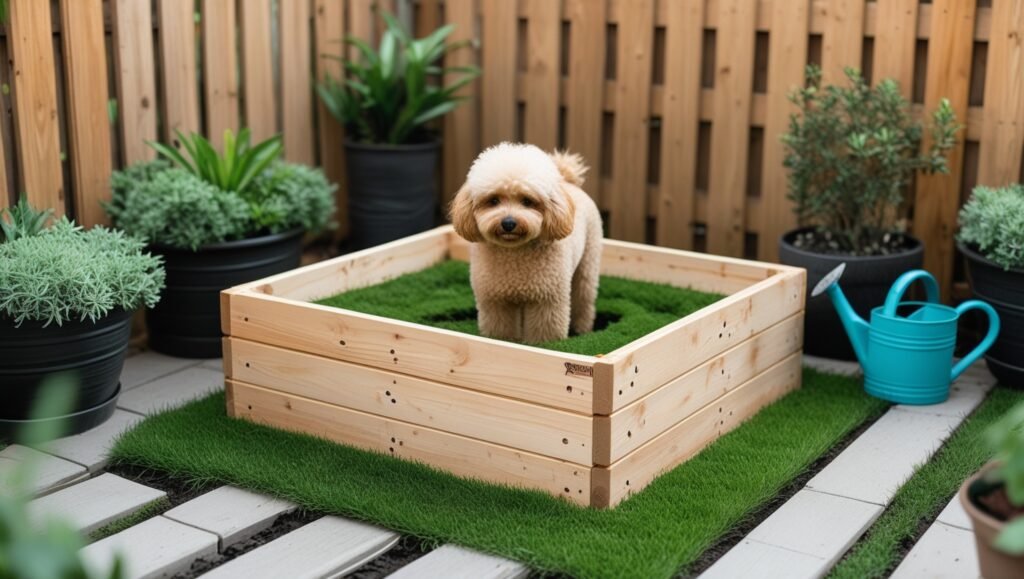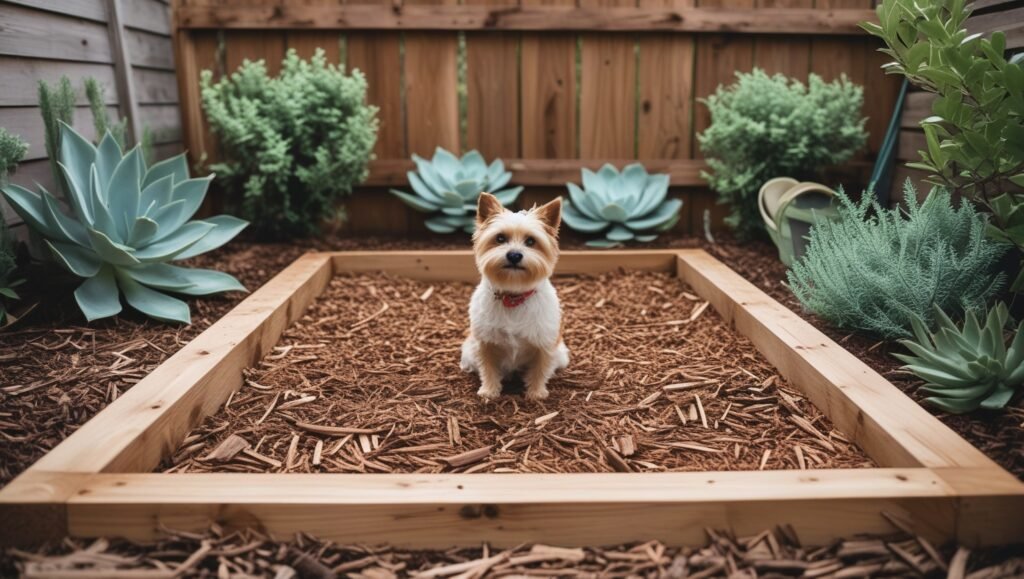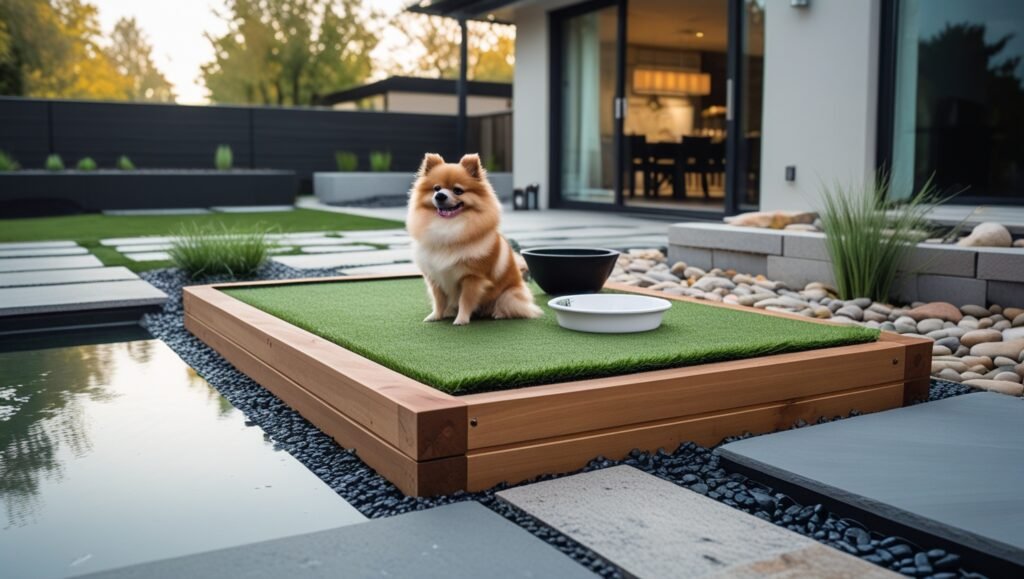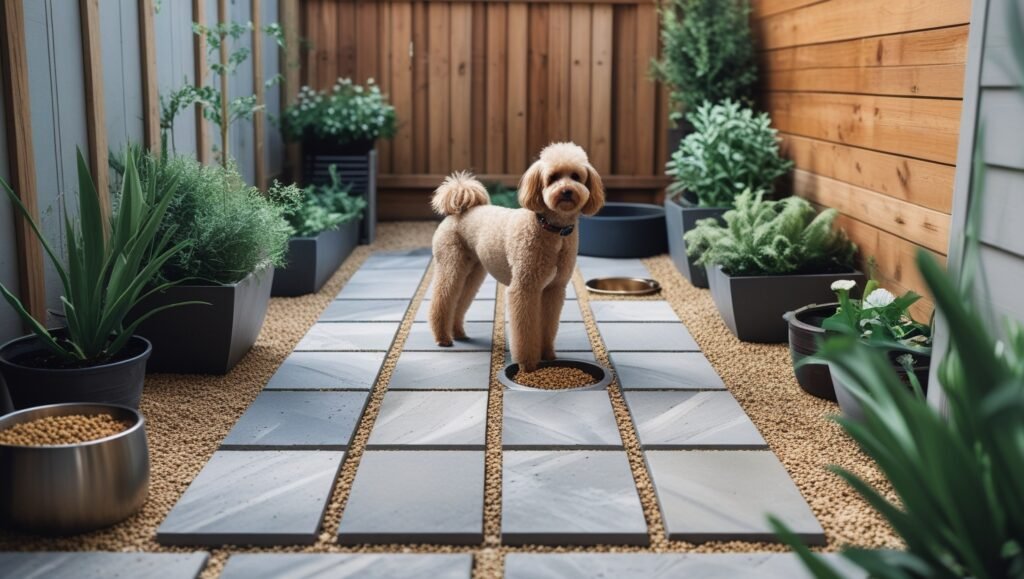Even if you have a small yard, it doesn’t mean that you can’t design a stylish and functional potty for your dog. A potty area will keep your yard odour free, clean and organised. It also gives your dog a place to relieve themselves. These ideas, whether simple or decorative, are easy to implement and designed for small spaces. You’ll find detailed instructions, helpful tips and all you need to start!
1. Gravel Potty Zone
Gravel potty zones are a great solution for backyards with limited space. They’re low maintenance, durable, and affordable. Gravel drains extremely well, so your dog’s area will not become a muddy mess when it rains. It is easy to replace this material if it gets too dirty over time. Gravel works well for households that have multiple dogs because it can withstand frequent use. You can also choose from a variety of styles to complement your yard’s look, while still providing a functional area for your dog.
- Dog-friendly pea gravel or smooth gravel
- Landscape fabric
- Borders can be made with bricks, wood, or metal.
Tools Required:
- Shovel
- Rake
- Measurement tape
- Stakes, string and other materials
How To Build It:
- Choose a Location: Pick a corner in your yard that drains naturally or is easily cleaned.
- Marking the Area: Use stakes or string to outline and measure the desired size and shape of the potty area.
- Prepare The Ground: Dig 4-6 inches deep into the ground to form a base. Rake it to make the ground level.
- Lay Landscape fabric: Place the landscape fabric over the gravel base to prevent weeds growing through.
- Add Gravel Cover the area in pea gravel. Make sure it is at least three inches thick.
- Create Borders: Use wood or bricks to create a boundary around the area. This will keep the gravel contained.
Tips:
- To keep the gravel clean, rinse it with a garden hose periodically.
- Avoid gravel with sharp edges that can hurt your pet’s paws.
2. Artificial Turf Toilet Area
Artificial turf is popular among pet-owners, who prefer the look and feel without the maintenance. This is particularly useful in small yards where natural grass may struggle to grow because of shade or heavy traffic. Turf looks green and fresh all year round and does not require watering or reseeding. The soft, grassy texture is loved by dogs, while pet parents appreciate how easy it can be to maintain and clean. Artificial turf is a great option for a small patio or narrow backyard. It will look polished and professional.
Materials Required:
- Artificial turf
- Crushed stone (or gravel) for drainage
- Weed barrier fabric
- Landscape staples or adhesive
Tools Required:
- Shovel
- Rake
- Utility Knife
- Measurement tape
How To Build It:
- Prepare Area: Level and clean the area where you intend to install turf.
- Create an Drainage Base: Spread 2-3 inches of crushed stone or pebbles to improve drainage. Compact it firmly.
- Add Weed Barriers: Spread weed barrier fabric on top of the gravel.
- Install Turf : Spread the artificial turf on the surface. To ensure a perfect fit, trim the edges with a utility blade.
- Fix the turf: Use adhesive or landscape staples to fix the turf.
Tips:
- Use pet-safe turf cleaning products to eliminate odours and clean the turf.
- Select turf that has perforations for proper drainage.
3. Wooden Potty Box With Sod
A wooden potty with sod will give you the natural look of grass while keeping your yard neat. This solution gives your dog a patch real grass, while also keeping your yard clean and free from wear and tear. This is a great option for those who rent and want to have a portable solution, or dog owners in cities with limited space. You can monitor the condition of the grass and replace it if necessary by confining it to a wooden framework. This will ensure that your dog has a potty area that is always clean and inviting.
Materials Required:
- Pressure-treated Wood (for the Box)
- Nails or screws
- Rolls of soil and sod
Tools Required:
- See
- Drill or Hammer
- Shovel
- Measurement tape
How To Build It:
- Create the Frame: Use treated wood under pressure to make a rectangular box. The pieces can be nailed or screwed together.
- Prepare Base: Dig a shallow area to sit the box in.
- Add soil and sod: Fill up the box with dirt, then add the sod rolls, pressing them firmly down.
- Keep the grass green: Regularly water the sod to keep it fresh.
Tips:
- To prolong the life span of your grass, place the box in an area that is shaded.
- Replace the sod if it is worn every few months.
4. Mulch Potty Area
Mulch potty areas are a natural and budget-friendly option for dog owners looking to create a potty zone that is functional without spending a lot of money. Mulch absorbs odours well and is a great material for potty area. Mulch blends in seamlessly with most backyard aesthetics. This is especially true if you use mulch as landscaping. Mulch is generally comfortable for dogs’ paws. It’s also environmentally friendly because it breaks down over time. You can choose from a range of mulch types and customise both the appearance and functionality of your potty area.
Materials Required:
- Avoid cocoa mulch as it is toxic to dogs.
- Landscape fabric
- Materials for edging (wood or metal).
Tools Required:
- Shovel
- Rake
- Measurement tape
How To Build It:
- Clean the Area: Select a corner in your yard to remove grass and debris.
- Use Landscape Fabric to Prevent Weeds: Lay down landscape fabric to stop weeds.
- Spread Mulch Fill in the area with 3-4 inchs of mulch.
- Add Borders : Use metal or wood edgings to contain the mulch.
Tips:
- Cedar mulch can help control odours.
- Replace the mulch every couple of months to keep it fresh.
5. Raised patio potty spot
A raised potty is the perfect solution for those who have a small patio or backyard with paved surfaces. You can keep your patio neat and tidy by elevating the potty. Pet owners can also benefit from this option, since raised planters and shallow boxes are easy to clean and move around. The compact design of raised patios is perfect for those who rent or have limited space. These raised patio spots are a great mix of design and functionality, giving your dog a place to relax without compromising the aesthetics of your yard.
Materials Required:
- Shallow wooden planter box or plastic planter boxes
- Artificial turf or Sod
- Drainage pebbles
Tools Required:
- Drilling (for drainage holes).
- Utility Knife
How To Build It:
- Prepare your Planter: Drill drainage holes into the bottom of the planter.
- Add a drainage layer: Place pebbles or gravel at the bottom of your planter.
- Install turf or sod: Lay the artificial turf or sand over top and secure.
Tips:
- Keep the planter clean to avoid odours.
- Renters will love this option because it is portable.
6. Sand Potty Pit
Sand potty pits are a dog-friendly and affordable option, especially for dogs who love to dig. Sand has a natural texture, which dogs love. It’s also easy to clean. Simply rake it to remove waste. This option is ideal for small backyards, as it’s easy to install and requires little maintenance. Sand drains very well and prevents puddles. This can be used as a dog play area, which makes it a multi-purpose addition to your yard. With the right border it can also be a functional and attractive feature.
Materials Required:
- Play sand that has been washed
- Landscape fabric
- Edge materials
Tools Required:
- Shovel
- Rake
How To Build It:
- Dig A Pit: Dig an shallow pit, and line it up with landscape fabric.
- Fill the Pit with Sand: Add clean play sand.
- Create Borders : Use edge materials to contain sand.
Tips:
- To maintain cleanliness, replace sand frequently.
- Cover the area when not in usage to prevent contamination.
7. Stone Paver Potty Zone
A potty nook with privacy fencing is an elegant and practical solution for dogs who are shy or prefer some seclusion. This design is not only a way to provide a specific area for your pet, but it also keeps the potty zone discrete and separate from the rest your yard. Privacy panels and lattice fencing can be customized to fit your backyard’s aesthetic. Decorative touches such as planters or vines will add charm. This option is great for small backyards as it helps to contain the space and keep it neat and out of view.
Materials Required:
- Stone pavers
- Crushed gravel (for drainage)
- Sand polymeric
Tools Required:
- Shovel
- Rubber mallet
- Measurement tape
How To Build It:
- Prepare Base: Dig the area out and add crushed gravel to the drainage layer.
- Lay Pavers Arrange your pavers according to your preferred pattern, but leave small gaps between them for drainage.
- Fill Gaps – Use polymeric Sand to fill in the gaps between pavers and stabilize them.
Tips:
- Keep the pavers clean by regularly hosing them down.
- Non-slip paving stones are the best way to keep you safe.
Success Tips:
- Location is Important: Make sure the toilet area is in an area that has good drainage.
- Train your Dog: Use positive reinforcement and treats to encourage you dog to use a designated area.
- Regular Cleaning: Remove waste every day and rinse to prevent odours.
Follow these instructions to create a stylish and functional dog potty in your backyard. Choose the best option for your dog, space and materials. Enjoy a more organized and cleaner outdoor space.
Conclusion – A functional and stylish potty area for your dog
It is important to maintain a tidy, clean outdoor space. There’s a solution for every dog and backyard, whether you choose a gravel area, lush artificial turf or a wooden potty. These designs are simple to construct, affordable and can be customized to suit your space and style.
Regular cleaning and training will ensure that your dog uses the space consistently, giving you a tidy, odour-free yard. Regular cleaning, along with some training will help your dog use the area consistently.
This guide will help you create a potty that is both pleasing to you and your pet. Grab your tools and get creative to build the perfect potty today!
